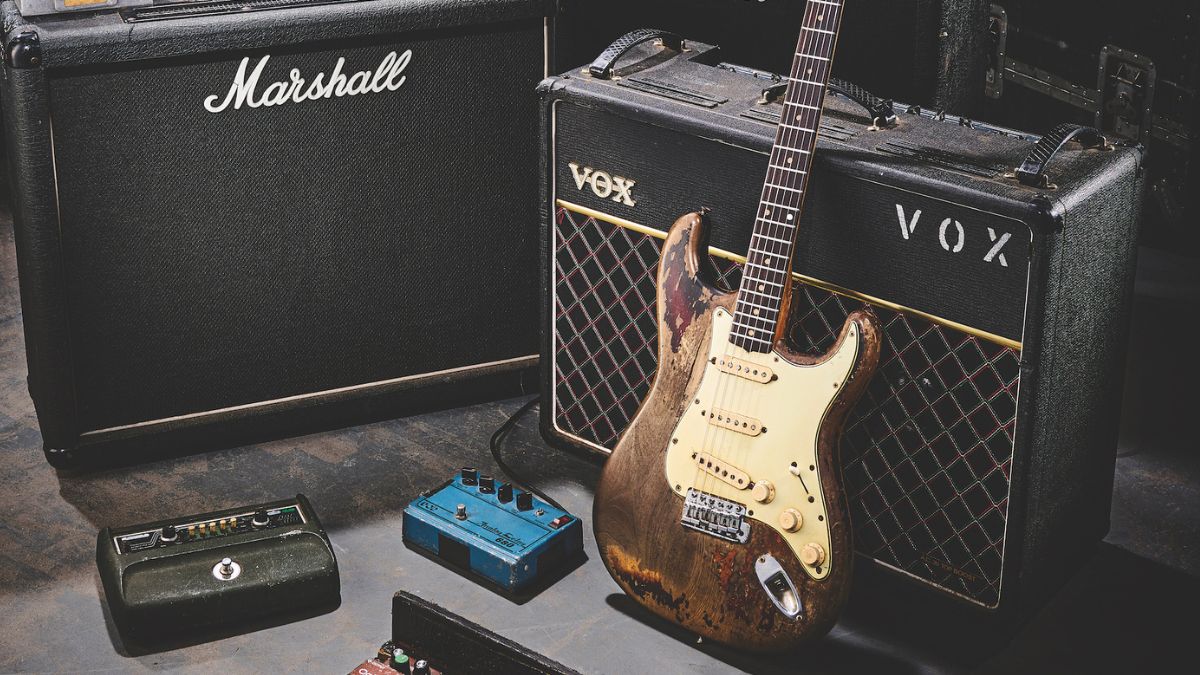"That's his DNA right there." Joe Bonamassa plays Rory Gallagher's "other" Strat. But his excitement isn't about the guitar
The blues guitarist was given a chance to play a pair of the Irish rocker's prized Fenders ahead of their auction

The auction of Rory Gallagher’s iconic, heavily relic’d Strat was a story that had the guitar world rapt this year. But while a campaign to keep what was the first Fender Strat to reach Irish shores in the country grabbed the headlines, a huge portion of Gallagher’s other amps, pedals, and guitars went under the hammer with little fanfare.
Rory’s brother and former manager, Dónal, had been charged with its safekeeping the guitarist's gear since his death in 1995. But before the collection left his family’s possession, Guitarist gave Joe Bonamassa the opportunity to play some of Rory's other prized electric guitars .
Lifelong Gallagher fan Bonamassa understands why the clamor around the auction was so laser-focused on that Strat — a 1961 model that Gallagher bought for £100 in 1963.
“A lot of the narrative is that Rory only used one guitar for his whole life," Bonamassa says. "He had a lot of guitars and a lot of amps. But he's most known for using the '61 Strat.”
Bonamassa's father introduced him to Gallagher's music through the guitarist's Live in Europe album. Joe recalled the impression the Irish rocker made on him.
“Here's this guy with long hair, a flannel shirt and he looked like he just came out of an auto factory playing some of the most gutbucket blues and rock you've ever heard.”
The beat-up Strat quickly became an extension of Gallagher, the “working class hero,” but, despite people’s affiliation between man and relic’d Strat, Bonamassa believes Gallagher saw his instruments as merely “tools…different instruments for different things.”
All the latest guitar news, interviews, lessons, reviews, deals and more, direct to your inbox!
Another Strat, a ‘58 model with a maple fretboard, served as his go-to backup. Bonamassa explained what he believes is the very human reason Gallagher was drawn to the Fender model.
“The Strat is a desert island guitar," he says. "You can pretty much do anything with it. You can play the blues, rock, you can play anything." And of course Rory was inspired to play the Stratocaster because his hero Buddy Holly did. "We all buy our guitar heroes' guitars," Bonamassa says. "I'm no different, Rory was no different.
Bonamassa also commented on the guitar itself.
“I don't know where he got this,” he says. “They weren't growing on trees. He probably bought it on the road in America from a little music store for the low hundreds of dollars. They're $45,000 now.
“This one's pretty cool because the logo is still intact. On a lot of '58s the logo flaked off. They were changing the process a little bit.”
Quizzed on why Gallagher bounced between the two different models, Bonamassa pointed towards the maple fretboard of the '58.
“There's a considerable sound difference between an all-maple Strat like this, and '61 Strat which would have been a slab rosewood fingerboard, meaning that the back and is maple, and there's a large slab of Brazilian rosewood on the front. It gives it a warmer, more rock sound.
“The '58s tend to be more glassy. If you're a Strat connoisseur like Rory, you want a rosewood and a maple neck, depending on the song. I prefer a maple neck because of Buddy Guy.”
It seemed Rory preferred the ballsier sound of rosewood.
It's believed that the finish, pickups, knobs and pickup switch are original parts. Bonamassa theorizes that the one-ply pickguard would have been changed out in the '80s or '90s. Extensive wear on the rear of the guitar shows how much Gallagher gigged with it, while it also reveals that its tremolo has been blocked off. He was never known to use whammy bars.
Away from Strats, Gallagher also played his '59 Fender Esquire. Its body shows signs of heavy scarring made worse after it was crushed on an airport runway. That was one of the very few occasions the guitar ever left his side since he came to own it.
Esquires were a single-pickup sidekick to the Telecaster, but it was soon modded with an after-market neck pickup. He wasn't the only one to do so.

“If everyone in the '70s buying these for $100 knew these would be worth five figures, no one would modify them,” Bonamassa reflects. “These were tools, they weren't collectibles.”
The earliest photos of Gallagher playing the guitar date to 1971. The guitar’s neckplate features the crudely engraved legend “Property Of Buzz Harding, Greensburg Kansas," a hint to its pre-Gallagher origins.
Bonamassa notes that the guitar hasn't been touched since Gallagher died in 1995. “A guitar that sits for 30 years will need a bit of work," he offers. "It's up to the buyer whether they wanna keep Rory's strings on it — which have been on it an effing long time — and get it back up playing.
“I think the worst-case scenario is someone hangs it on their wall and brags to their rich buddies that they bought it. These things are tools and they should make music again.

“The action seems like it was set up for slide. Rory tended to like monster frets and these are really monster frets. It's a great, honest instrument.”
However, he says “the coolest thing” about the guitar is the strap that comes with it. “That's his DNA right there,” he smiles. “It's very cool to have the guitar strap and the tape he used [to hold it together].”
Reflecting on his time playing the two instruments, he says “it's clear these were tools to Rory,” and believes that “a good part of this collection will be back out there making music,” keeping the spirit of Rory Gallagher alive.
Rory’s ‘61 Strat sold for $1.16 million and has since been donated to the National Museum of Ireland. It came after a GoFundMe page — set up by the daughter of the man who sold Rory the guitar — and Irish politicians lobbied for it to stay in Ireland.
A freelance writer with a penchant for music that gets weird, Phil is a regular contributor to Prog, Guitar World, and Total Guitar magazines and is especially keen on shining a light on unknown artists. Outside of the journalism realm, you can find him writing angular riffs in progressive metal band, Prognosis, in which he slings an 8-string Strandberg Boden Original, churning that low string through a variety of tunings. He's also a published author and is currently penning his debut novel which chucks fantasy, mythology and humanity into a great big melting pot.



